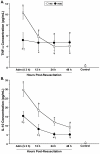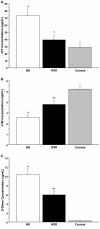Prehospital resuscitation with hypertonic saline-dextran modulates inflammatory, coagulation and endothelial activation marker profiles in severe traumatic brain injured patients
- PMID: 20082712
- PMCID: PMC2819256
- DOI: 10.1186/1742-2094-7-5
Prehospital resuscitation with hypertonic saline-dextran modulates inflammatory, coagulation and endothelial activation marker profiles in severe traumatic brain injured patients
Abstract
Background: Traumatic brain injury (TBI) initiates interrelated inflammatory and coagulation cascades characterized by wide-spread cellular activation, induction of leukocyte and endothelial cell adhesion molecules and release of soluble pro/antiinflammatory cytokines and thrombotic mediators. Resuscitative care is focused on optimizing cerebral perfusion and reducing secondary injury processes. Hypertonic saline is an effective osmotherapeutic agent for the treatment of intracranial hypertension and has immunomodulatory properties that may confer neuroprotection. This study examined the impact of hypertonic fluids on inflammatory/coagulation cascades in isolated head injury.
Methods: Using a prospective, randomized controlled trial we investigated the impact of prehospital resuscitation of severe TBI (GCS < 8) patients using 7.5% hypertonic saline in combination with 6% dextran-70 (HSD) vs 0.9% normal saline (NS), on selected cellular and soluble inflammatory/coagulation markers. Serial blood samples were drawn from 65 patients (30 HSD, 35 NS) at the time of hospital admission and at 12, 24, and 48-h post-resuscitation. Flow cytometry was used to analyze leukocyte cell-surface adhesion (CD62L, CD11b) and degranulation (CD63, CD66b) molecules. Circulating concentrations of soluble (s)L- and sE-selectins (sL-, sE-selectins), vascular and intercellular adhesion molecules (sVCAM-1, sICAM-1), pro/antiinflammatory cytokines [tumor necrosis factor (TNF)-alpha and interleukin (IL-10)], tissue factor (sTF), thrombomodulin (sTM) and D-dimers (D-D) were assessed by enzyme immunoassay. Twenty-five healthy subjects were studied as a control group.
Results: TBI provoked marked alterations in a majority of the inflammatory/coagulation markers assessed in all patients. Relative to control, NS patients showed up to a 2-fold higher surface expression of CD62L, CD11b and CD66b on polymorphonuclear neutrophils (PMNs) and monocytes that persisted for 48-h. HSD blunted the expression of these cell-surface activation/adhesion molecules at all time-points to levels approaching control values. Admission concentrations of endothelial-derived sVCAM-1 and sE-selectin were generally reduced in HSD patients. Circulating sL-selectin levels were significantly elevated at 12 and 48, but not 24 h post-resuscitation with HSD. TNF-alpha and IL-10 levels were elevated above control throughout the study period in all patients, but were reduced in HSD patients. Plasma sTF and D-D levels were also significantly lower in HSD patients, whereas sTM levels remained at control levels.
Conclusions: These findings support an important modulatory role of HSD resuscitation in attenuating the upregulation of leukocyte/endothelial cell proinflammatory/prothrombotic mediators, which may help ameliorate secondary brain injury after TBI.
Trial registration: NCT00878631.
Figures





Similar articles
-
Prehospital hypertonic saline resuscitation attenuates the activation and promotes apoptosis of neutrophils in patients with severe traumatic brain injury.Shock. 2013 Nov;40(5):366-74. doi: 10.1097/SHK.0000000000000038. Shock. 2013. PMID: 24088993 Free PMC article. Clinical Trial.
-
Resuscitation of traumatic hemorrhagic shock patients with hypertonic saline-without dextran-inhibits neutrophil and endothelial cell activation.Shock. 2012 Oct;38(4):341-50. doi: 10.1097/SHK.0b013e3182635aca. Shock. 2012. PMID: 22777113 Free PMC article. Clinical Trial.
-
Resuscitation with hypertonic saline-dextran reduces serum biomarker levels and correlates with outcome in severe traumatic brain injury patients.J Neurotrauma. 2009 Aug;26(8):1227-40. doi: 10.1089/neu.2008.0868. J Neurotrauma. 2009. PMID: 19637968 Clinical Trial.
-
The use of hypertonic saline for treating intracranial hypertension after traumatic brain injury.Anesth Analg. 2006 Jun;102(6):1836-46. doi: 10.1213/01.ane.0000217208.51017.56. Anesth Analg. 2006. PMID: 16717334 Review.
-
Individual patient cohort analysis of the efficacy of hypertonic saline/dextran in patients with traumatic brain injury and hypotension.J Trauma. 1997 May;42(5 Suppl):S61-5. doi: 10.1097/00005373-199705001-00011. J Trauma. 1997. PMID: 9191698 Review.
Cited by
-
ROC trials update on prehospital hypertonic saline resuscitation in the aftermath of the US-Canadian trials.Clinics (Sao Paulo). 2013 Jun;68(6):883-6. doi: 10.6061/clinics/2013(06)25. Clinics (Sao Paulo). 2013. PMID: 23778489 Free PMC article. Review.
-
Neutrophil elastase mediates acute pathogenesis and is a determinant of long-term behavioral recovery after traumatic injury to the immature brain.Neurobiol Dis. 2015 Feb;74:263-80. doi: 10.1016/j.nbd.2014.12.003. Epub 2014 Dec 9. Neurobiol Dis. 2015. PMID: 25497734 Free PMC article.
-
Long-Term Kinetics of Immunologic Components and Neurological Deficits in Rats Following Repetitive Mild Traumatic Brain Injury.Med Sci Monit. 2017 Apr 8;23:1707-1718. doi: 10.12659/msm.901124. Med Sci Monit. 2017. PMID: 28390198 Free PMC article.
-
An analysis of neutrophil-to-lymphocyte ratios and monocyte-to-lymphocyte ratios with six-month prognosis after cerebral contusions.Front Immunol. 2024 Mar 12;15:1336862. doi: 10.3389/fimmu.2024.1336862. eCollection 2024. Front Immunol. 2024. PMID: 38545111 Free PMC article.
-
Endothelial activation and chemoattractant expression are early processes in isolated blast brain injury.Neuromolecular Med. 2014 Sep;16(3):606-19. doi: 10.1007/s12017-014-8313-y. Epub 2014 May 25. Neuromolecular Med. 2014. PMID: 24858498
References
-
- Schmidt OI, Infanger M, Heyde CE, Ertel W, Stahel PF. The role of neuroinflammation in traumatic brain injury. Eur J Trauma. 2004;3:135–149.
Publication types
MeSH terms
Substances
Associated data
LinkOut - more resources
Full Text Sources
Medical
Research Materials
Miscellaneous

